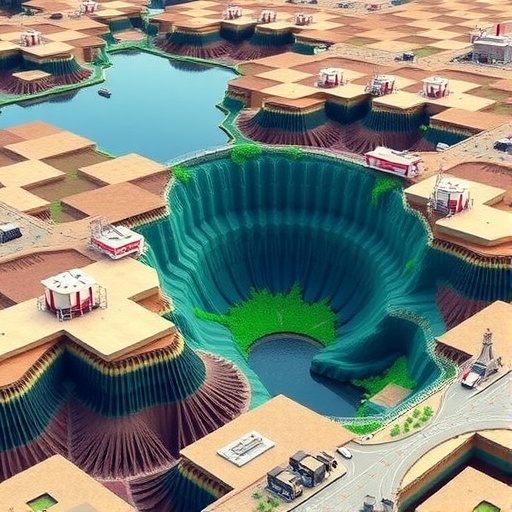Recent developments in reservoir and catchment calculations reveal significant advancements in our understanding of environmental emissions associated with new dam constructions. Leveraging tools like GeoCARET—a cutting-edge Geospatial Catchment and Reservoir Analysis Tool—researchers have developed a streamlined approach for mapping and evaluating the intricate relationships between hydrological dynamics and greenhouse gas emissions. By utilizing satellite-based platforms such as Google Earth Engine, GeoCARET effectively processes vast datasets to provide crucial insights into the environmental impacts of reservoirs across varied geological and climatic contexts.
This innovative model operates on three essential steps: catchment delineation, reservoir delineation, and the computation of environmental parameters. At the heart of its methodology lies the integration of different geospatial layers that inform critical decision-making regarding water management and resource allocation. This process begins with the identification of the geometric footprints of reservoirs and their contributing catchments, yielding valuable data that can influence future infrastructural planning and climate strategy.
Specifically, catchment delineation relies upon detailed hydrological mapping, which incorporates global datasets like Hydrobasins, Hydrorivers, and the Hydrosheds Flow Accumulation datasets. These data sources offer critical insight into river networks and the flow characteristics necessary to optimize water resource management. Moreover, the integration of multiple datasets allows for robust analysis, providing clearer delineation of sub-basins involved in water flow—essential for accurate greenhouse gas emission estimations linked to dam constructions.
On the other hand, reservoir delineation methodologies differ based on the status of the infrastructure, providing a nuanced analysis of both planned and existing reservoirs. Planned reservoirs use hydrologically conditioned digital elevation models to predict inundation areas, while existing reservoirs depend on historical land cover maps. Such distinctions are vital, as they allow for more accurate assessments of environmental impacts based on the unique characteristics and operational phases of each reservoir.
The computational workflow further enhances the efficiency of this analysis, as it facilitates the quantifiable assessment of hydromorphological and climatic data, enabling researchers to analyze the emissions landscape influenced by these water bodies. By systematically intersecting geospatial layers, researchers can calculate essential metrics regarding the flux of greenhouse gases resulting from both the operational and ecological aspects of reservoirs.
A focal point of this research is the deployment of the RE-Emission model, which facilitates the estimation of greenhouse gas emissions derived from reservoirs. This tool stands out for its comprehensive design, incorporating variables that characterize reservoir properties and local environmental conditions. Structured around the G-res methodology, RE-Emission strengthens the analytical framework needed to address the multifaceted implications of hydropower development on regional ecosystems.
In evaluating the net anthropogenic greenhouse gas emissions associated with reservoirs, the G-res model focuses on several critical emission pathways, including both diffusive and bubbling emissions. The model estimates not just the emissions produced directly by reservoirs, but also considers the broader ecological footprint resulting from land use changes and nutrient inflows from surrounding human activities. Such strategic modeling ensures that stakeholders have access to the necessary information to make informed decisions aimed at reducing the carbon footprint of new infrastructures.
Additionally, the study presents critical insights into country-specific emission factors derived from a detailed regression analysis, which fine-tunes existing global data to meet local conditions. By applying this localized approach, the researchers can effectively calibrate emission factors to reflect the unique climatic zones characteristic of Myanmar and enhance the accuracy of emissions reporting.
The implications of these methodologies extend beyond data collection; they herald a new era of responsible planning in hydropower development. By prioritizing emissions modeling, policymakers and environmentalists can better evaluate the sustainability of proposed dam constructions, helping guide investments toward lower-emission alternatives. Thus, the research calls for a concerted effort to integrate environmental considerations into hydropower planning, advocating for the utilization of advanced emission models as standard practice.
The authors highlight the pressing need for a holistic vision that recognizes emissions management as integral to the design and operation of hydropower projects. Utilizing these datasets, including socio-economic and ecological considerations, allows for a multiobjective optimization approach that balances hydropower production with environmental stewardship. Such a framework will ultimately lead to more sustainable hydropower practices.
Furthermore, the research emphasizes the importance of incorporating explanatory artificial intelligence (xAI) tools into the decision-making process. By offering insights into how various factors influence greenhouse gas emissions, stakeholders can better understand the complexity of these interactions and make data-driven decisions that benefit both development and conservation efforts.
The promising findings from this research necessitate further collaboration between scientists, policymakers, and the public to foster an environmentally conscious approach to hydropower. As global energy needs rise, the insights gained from these innovative modeling endeavors will undoubtedly play a pivotal role in shaping future infrastructure projects, ensuring they align with sustainable practices that address climate change.
In conclusion, the ongoing analysis of reservoir and catchment dynamics underscores the vital importance of adopting advanced methodologies in planning hydropower development. By integrating high-resolution geospatial data with innovative emission modeling, researchers are paving the way for a more sustainable energy future, balancing the dual imperatives of development and environmental protection. The momentum generated by these advancements is likely to resonate throughout the industry, encouraging a reevaluation of how water resources are harnessed in a changing climate.
Subject of Research: Environmental impact of reservoir constructions
Article Title: Planning with emission models reduces the carbon footprint of new reservoirs
Article References:
Janus, T., Barry, C., Win, S. et al. Planning with emission models reduces the carbon footprint of new reservoirs.
Commun Earth Environ 6, 953 (2025). https://doi.org/10.1038/s43247-025-02899-6
Image Credits: AI Generated
DOI: https://doi.org/10.1038/s43247-025-02899-6
Keywords: Reservoir emissions, greenhouse gas emissions, hydropower, sustainability, GeoCARET, RE-Emission, G-res model, environmental impact, hydrology, catchment analysis.




